
- DONATION
- 2023 WINTER
Interview on Donation for UNIST
본문영역
2023 WINTER
Interview on Donation for UNIST
We’ve interviewed Kim Sung-hwan, the president of the UNIST Alumni Association, who has led various activities with love for his alma mater and donated regularly to the school from 2021.
Q1Would you start by introduce yourself?
Hello, my name is Kim Sung-hwan and I’ve graduated from the UNIST School of Business Administration. I’m currently working in the Finance Department at Samsung Electronics and was appointed as the 2nd president of the association in 2019. I have hosted two alumni events so far as president and a variety of events are taking place to encourage people to become members. An online “screen golf contest” is expected to take place for the first time at the end of this year, for which I will be awarding the winner prize money at my own expense.
Q2Would you introduce the UNIST Alumni Association?
The UNIST Alumni Association, organized in 2016, consists of regular members who paid membership fees to join, and associate members who did not. There are over 400 regular members as of today. Not all graduates are members of the Association since it is not mandatory. However, we are strengthening the basis of the Association so that it stands strong, in the belief that graduates will one day feel they need help from this.
The Association carries out a variety of projects. The “Alumni Night” is literally an event where UNIST graduates gather and dine together, and the event hosted in Seoul in 2019 had more than 150 participants. It was a joyous time enjoying stand-up comedy together and exchanging phone numbers with long-lost friends. We also hosted an event last year where around 30 alumni who returned to their alma mater as professors met with the president and vice-president of the school and academic advisors.
During the graduation ceremony this year in March, we ran a photo booth sponsored by the Alumni Association and donated the proceeds of KRW 1.004 million to the school’s development fund. We are supporting the exchanges between alumni and the development of UNIST through these small and large-scale events.

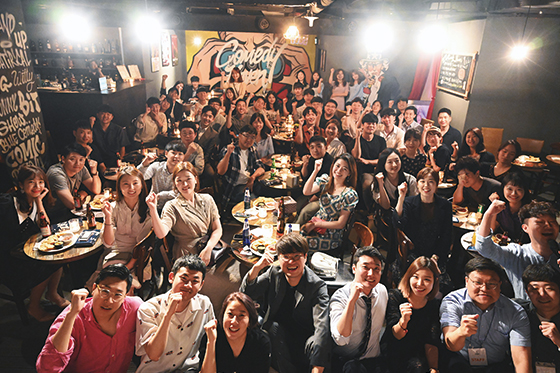
Q3You have been regularly donating to your alma mater since 2021. Is there a reason why you started regular donating?
I have been donating a fixed amount to the school monthly. Before, I used to think that donation meant giving hundreds of millions or billions of won, as we often see on the news. That’s why I always told myself when I was young that I would one day become this amazing person that donated a large amount of money. And it’s probably not just me about this idea. One day, it occurred to me that by continuing to donate regularly, even if it may not be a lot each time, I would someday fulfill my childhood dream.
Another reason why I began donating is because it seemed like a way to keep me connected to my alma mater even after graduation. I meet many alumni who participated in various school activities back when they were students from affection toward the school. To me, donation is a way of showing support for your alma mater after graduation, based on the same affectionate feeling.
Q4You mentioned that you would like for the donation to be used for the Vision 2030. Can you be more specific?
My understanding is that UNIST’s Vision 2030 is to be ranked among the world’s top-10 universities in the science and technology field by 2030. And I know for a fact that UNIST is getting closer to achieving this vision. The university’s two-pronged strategy for realization of the vision includes “research” and “education.” I would like for my contribution to be used particularly for “Education: Nurturing global leaders of creative science and technology who can pioneer the future.” This is because education includes creating an ideal environment for the students to study in pleasant surroundings. I would like to see investments made in education facilities including lecture rooms or academic information centers so that global leaders can be cultivated in a better environment.
I used to take classes in the main building back in 2009 when I entered university. I remember sneaking into the construction site of the gym with my friends before it was finished. I heard that the newly renovated academic information center looks amazing. I look forward to seeing other facilities renovated as well.
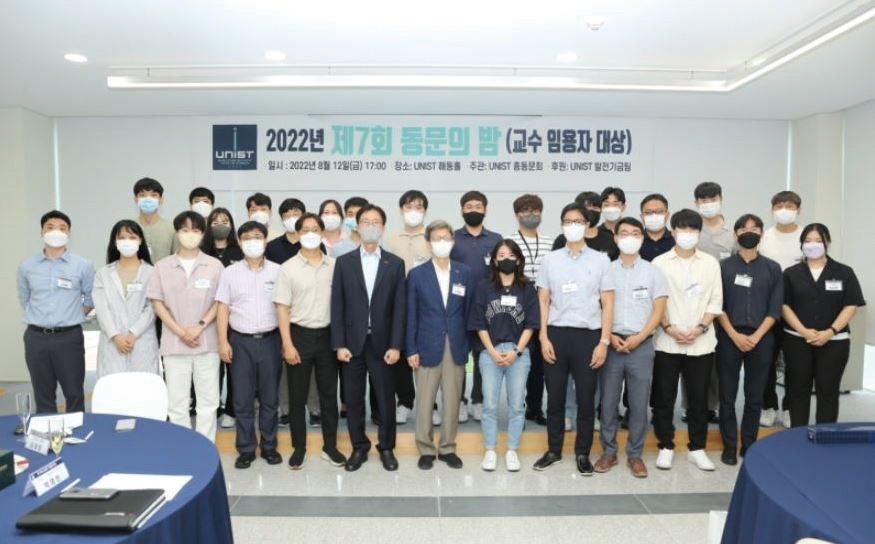
Q5Many people find it difficult to understand the importance of donation or why it’s necessary. Why do you think donating to UNIST is important?
First of all, your donation to your alma mater is partially refundable, because you get a tax credit (laughs)! The reason why you don’t feel that donation is important or necessary is because there isn’t any intuitive or visible outcome for your effort of donating. I feel the same way. It’s especially since most alumni are still in their twenties and thirties. Therefore, we can’t really relate to stories we see on the news of some CEO of a company who donated a huge amount of money.
I believe that the school should prove that Vision 2030 leads to substantial changes for graduates to start voluntarily donating to their alma mater. Graduates that feel that the growth and development of their alma mater boosts their own status will voluntarily start donating, and their contribution will be reinvested in the further development of the school, creating a virtuous cycle. This is why I think donating to UNIST is important.
Meanwhile, we can also have more graduates participate in donation if the system is improved so that the Association receives regular donations by credit or debit card. It’s extremely easy for individuals to donate to UNICEF or animal protection organizations because they have such a system in place. Moreover, KAIST posts a list on their website of all the contributors who made a donation to the school, from the first contributor in the 1980s to the 150,000th contributor recently. Changing the way respecting donors is one way of encouraging more donation. Many people become interested when donors sometimes post pictures on social media of the gifts they received for their contribution. I believe that if we encourage this kind of donor respecting well and publicizing how we treat our donors, more and more alumni with their dear and love for alma mater would join the donation effort.
Q6What role has UNIST played for you when you pursued your dream after graduation? What role would you like the alumni to fulfill after graduation?
Banyeon-ri is a place for me with lots of cherished memories. I feel very grateful to this place as it gave warmth to not only me, but every one of our alumni, and helped us make so many people happy with their memories as young students with amazing people. When I meet my fellow alumni, they often tell me how lucky they are to have UNIST as their alma mater. There were many advantages we could enjoy that didn’t exist in most universities. We were able to quickly improve our capabilities and competency thanks to our professors, whom we all respect so much, plus the cutting-edge research infrastructure, and the fact that professors could take better care of us thanks to there weren’t many students. All of these factors served as good stepping-stones for achieving our dreams.
There are many alumni who strive to return their gratitude to the school by contributing to the lives of mankind. I look forward to seeing both UNIST and its alumni grow together by each doing the best that is possible.
Q7Is there something you’d like to share with UNIST alumni and students?
I hope you always do your best in everything you do with fond memories of the school, and join the Alumni Association when you begin to feel lonely and miss your fellow alumni to achieve the vision together.
BULLETIN 1.
UNIST Development Foundation Commences Social Contribution Program
In November, as part of the social contribution activities to share UNIST’s vision, the UNIST Development Foundation (President: Yong Hoon Lee) donated a development fund worth a total of KRW 7 million to the regional science high schools (Ulsan Science High School, Busan Il Science High School, Gyeongnam Science High School) in Busan, Ulsan, and Gyeongnam, and hosted a fund delivery ceremony. The fund will be utilized as educational and activity fees for cultivating future science intellectuals. The UNIST Development Foundation has been providing support for the educational activities of science high schools in Busan, Ulsan, and Gyeongnam to nurture science talents from 2022, and will continue to carry out diverse activities toward that end.
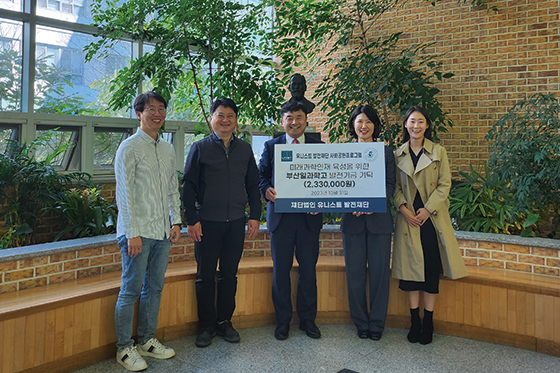
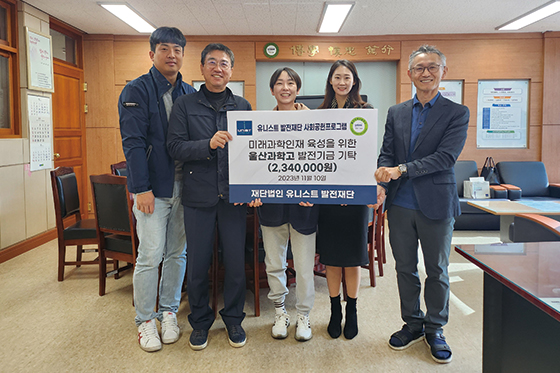
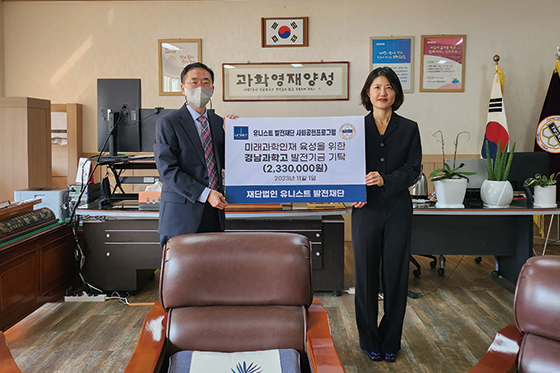
BULLETIN 2.
Hyunsong Educational & Cultural Foundation Donates Research Grant for New UNIST Professors
In October, the Hyunsong Educational & Cultural Foundation donated development funding worth KRW 300 million as a research grant. The development fund will be used for building a laboratory for outstanding new professors in the key research area at UNIST, and for purchasing research equipment. UNIST expressed the hope that the grant will help create an ideal environment for the new professors with excellent performance to adapt quickly and focus on research. The Hyunsong Educational & Cultural Foundation was founded by Chang-kyun Chu in 1974, and has since been carrying out social contribution activities including scholarship programs for nurturing talents, and academic research support programs.
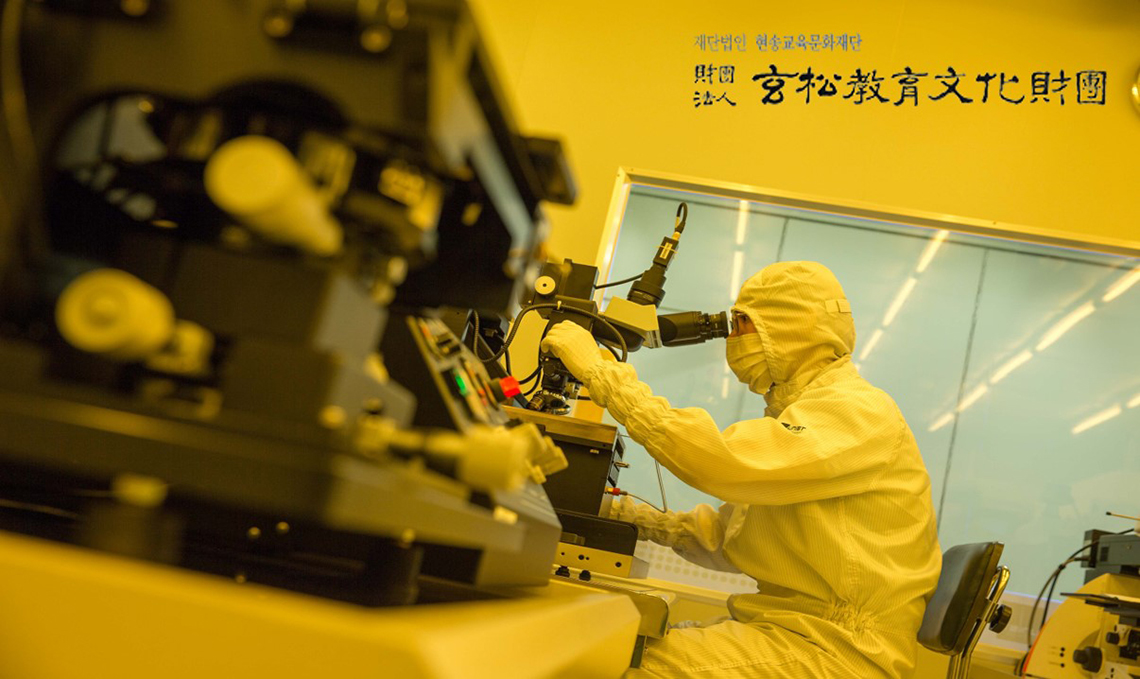
Send Your Message of Love!
Send UNIST your message of love for the cultivation of creative global intellectuals, the tiny seeds that drive the development of science and technology, and for constant challenges for a brighter future. We will prepare the way toward a brighter future for UNIST with grateful hearts!
-
Types of
Development
Fund -
-
General
Development Fund: -
- Contributions made by donators without specifying the purpose or department that will be utilizing the fund
-

-
Designated
Development Fund: -
- Contributions made by donors with designation of the purpose of use and department for utilizing the fund. There are four types of designated funds
-

-
General
-
List of donators for
Development Fund (Mar. 09, 2023 ~
Dec. 06, 2023 in order of date) -
-
- Lump Sum Payments (Cash)
-
- Designated donation of KRW 10 million from INTERX to the Graduate School in Technology and Innovation Management
- Designated donation of KRW 30.5 million from Gray Whale Offshore Wind Power Co., Ltd. to the Graduate School of Technology and Innovation Management
- KRW 1.004 million from the UNIST Alumni Association
- KRW 400 million from Gyeongnam Bank
- KRW 100,000 from No Eul Kim
- Designated donation of KRW 5 million from Professor Lee Yong-jae to the Department of Industrial Engineering
- Designated donation of KRW 1 million from Professor Chiehyeon Lim to the Department of Industrial Engineering
- Scholarship donation of KRW 4.34 million from Korea Electric Power Corporation
- Designated donation of KRW 10,000 from Kim Su-bin, a UNIST student, for the Department of Urban and Environmental Engineering
- Donation of KRW 713,000 from the College of Information and Biotechnology
- Donation of KRW 455,000 from the UNIST Child Education Center
- Donation of KRW 450,000 from Professor Jae Sung Lee
- Designated infrastructure donation of KRW 200,000 from Professor Ja Hyoung Ryu
- Designated donation of KRW 750,000 from Professor Park Soo-jin of POSTECH for the School of Energy and Chemical Engineering
- Donation of KRW 250,000 from Professor Gwon Seong-woo from Hankyong National University, an alumnus of UNIST
- Donation of KRW 500,000 from Vice President Lee Jai-yong
- Donation of KRW 500,000 from Professor Lee Kyung-han from Seoul National University
- Designated donation of KRW 3 million from Day 1 Company for the Department of Industrial Engineering
- Donation of KRW 1 million from Kim Jeong-ah, a parent of a student attending UNIST
- Designated donation of KRW 10 million from Professor Baek Jong-beom for the School of Energy and Chemical Engineering
- Designated research donation of KRW 1 million from Song Ji-hee, a parent of a student attending UNIST
- Designated donation of KRW 30.5 million from Gray Whale Offshore Wind for the Graduate School in Technology and Innovation Management
- Designated research donation of KRW 300 million from Hyunsong Educational & Cultural Foundation
- Donation of KRW 2 million from Professor Lee Jung-hye of Seoul National University for the Department of Industrial Engineering
- Designated Infrastructure donation of KRW 2.749 billion from Duksan Group Chairman Lee Jun-ho
- Donation of KRW 351,503 from Professor Lee Myong-in
- Designated Minari scholarship donation of KRW 200,000 from Professor Kim Jin-young for the School of Liberal Arts
- Donation of KRW 100,000 from Um Ji-yoon, a parent of a student attending UNIST
- Designated scholarship donation of KRW 5 million from Baek Jae-ho, the Director of We.Smile Orthodontic Clinic
-
- Regular Giving Service Agreement (New)
-
- Designated monthly donation of KRW 10,000 from Hong Chae-young, an alumnus, for the Department of Mechanical Engineering
- Designated monthly donation of KRW 10,000 from Lee Seung-min, a student at UNIST for infrastructure development
- Designated monthly donation of KRW 10,000 from Jung Jong-min, a staff member, for research funds
- Designated monthly donation of KRW 10,000 from Professor Kim Jae-ick for scholarship funds
- Designated monthly donation of KRW 10,000 from Professor Lee Myeong-hee for infrastructure funds
- Designated monthly donation of KRW 50,000 from Professor Kim Gi-soo for scholarship funds
- Monthly donation of KRW 100,000 from Kim Jeong-ah, a parent of a student attending
- Donation In-kind
-
- SK Gas’ support in establishment of Jigwanseoga (amount: KRW 12.67 million)
-
-
-

- Donate development fund Click!
-
-
-
Contact

-
E-mail: unist-gift@unist.ac.kr
Tel. 052-217-1282
Fax. 052-217-1289
H.P. fund.unist.ac.kr
-
Contact

